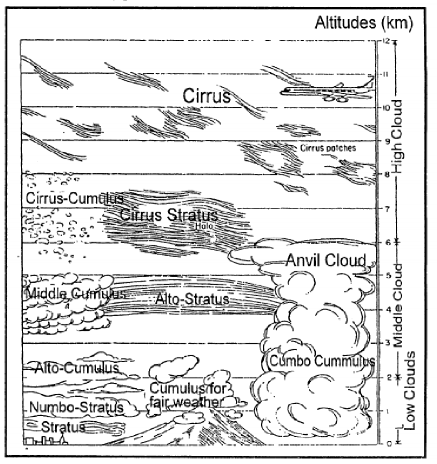16. International Classification of Clouds

The World Meteorological Organisation presented a detailed International Atlas of Clouds mentioning three main groups and ten main types of clouds.
Cloud Group | Height in meters | Cloud Types | |
High Clouds = Cirrus | 6000- 12000 | 1. Cirrus 2. Cirrostratus2 3. Cirrocumulus | High-level clouds form above 6,000 meters and since the temperatures are so cold at such high elevations, these clouds are primarily composed of ice crystals. High-level clouds are typically thin and white in appearance, but can appear in a magnificent array of colors when the sun is low on the horizon. |
Middle Clouds = Alto | 2000- 6000 | 4. Altostratus 5. Altocumulus | The bases of mid-level clouds typically appear between 2,000 to 6,000 meters. Because of their lower altitudes, they are composed primarily of water droplets, however, they can also be composed of ice crystals when temperatures are cold enough. |
Low Clouds = Stratus | below 2000 | 6. Stratus 7. Stratocumulus 8. Nimbostratus | Low clouds are of mostly composed of water droplets since their bases generally lie below 2,000 meters. However, when temperatures are cold enough, these clouds may also contain ice particles and snow. |
Clouds with Vertical Growth | 9. Cumulus 10. Cumulonimbus | Probably the most familiar of the classified clouds is the cumulus cloud. Generated most commonly through either thermal convection or frontal lifting, these clouds can grow to heights in excess of 12,000 meters, releasing incredible amounts of energy through the condensation of water vapor within the cloud itself. | |
Special Clouds | Mammatus Lenticular Fog Contrails | ||

2 Sun’s Halo is produced by the ice crystals in cirrostratus clouds high (5–10 km) in the upper troposphere.

